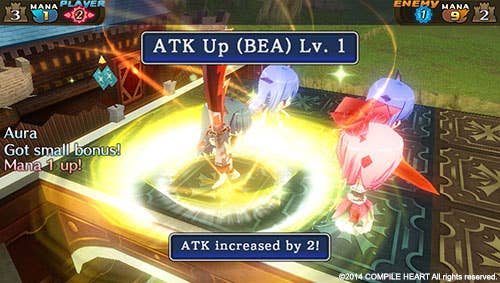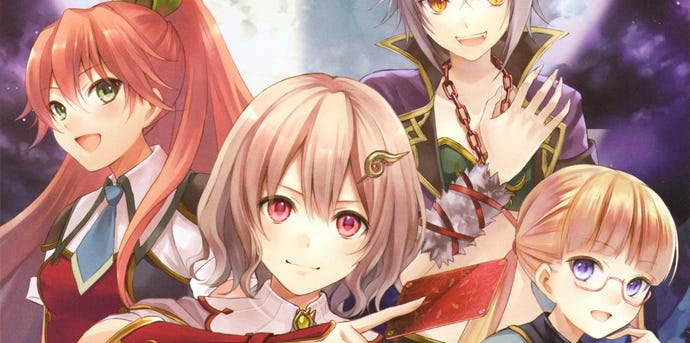JPgamer: Games You Thought Would Never Make it West #1
Although an official announcement is yet to appear, it looks very much like Compile Heart's Monster Monpiece is coming to the West. But what on Earth is this crazy game that some thought we'd never see in English?
This article first appeared on USgamer, a partner publication of VG247. Some content, such as this article, has been migrated to VG247 for posterity after USgamer's closure - but it has not been edited or further vetted by the VG247 team.
Well, um, gosh. I must confess I never thought I'd see a day when notorious Vita-rubbing game Monster Monpiece would be available in English, but it looks like that day is coming.
An official announcement is yet to be emerge, but eagle-eyed fans recently spotted English language screenshots of the game over on Idea Factory International's website. Idea Factory International, in case you haven't been following, is a North American-based branch of the Japanese developer-publisher behind titles such as the Agarest and Neptunia series, and its site aims to offer information on both localized releases of Idea Factory and Compile Heart games as well as those which are, to date, only available in Japan.
Further evidence that the game is being localized comes in the form of a PEGI rating -- the European equivalent of the ESRB -- that rates the game as suitable for players 12 and older, and warns of "non-realistic looking violence towards human characters, sexual images and/or sexual innuendo" as well as the fact the game features online play.

If you've heard of Monster Monpiece at all, it's probably for negative reasons. Kotaku branded the Japanese version "the most inappropriate PlayStation Vita game yet" while Destructoid's report on the game's existence focused entirely on the fact that one particular aspect of the game made you look a bit like, perhaps, possibly, you might be, uh, pleasuring your Vita.
In line with a lot of other coverage of the more seemingly "out there" Japanese titles, though, there wasn't a lot of attention paid to the actual game side of things. So, since it looks like we're going to get the chance to play this in the West at some point in the future, let's at least attempt to redress that balance by looking a little at how it actually plays.
Essentially, it's a card-battling game that unfolds on a 7x3 board. A 3x3 area on one side of the board belongs to you, while another 3x3 area on the other side belongs to your opponent, with a 1x3 column down the middle as a "neutral" zone. On your turn, you can summon cards into your area by expending mana, which builds up at a rate of 3 per turn. You can save up mana by passing a turn and consequently be able to summon more expensive, powerful cards, but you can also get mana bonuses from playing consecutive cards of the same color -- the first like-colored card you play gives you one bonus mana, for example, while the second gives you three extra mana -- effectively an extra turn's worth -- plus gives all your cards that are already out a significant stat boost. On top of that, you can summon cards of the same type on top of each other, which then combine and stack their stats.

Once cards are summoned, they'll move forward one space on the board towards your opponent and either attack enemies in front of themselves or aid nearby allies. The eventual aim of a battle is to use your cards to whittle down your opponent's defenses by getting them to the last space on their side of the field. In other words, you'll need to carefully use your cards to protect your own base while pushing forward and taking on the enemy.
Outside of battle, there's a story mode and a customizable card game-style metagame to indulge in, in which you can build your own deck and fill it with the cards you've found most useful or helpful. You can then take these decks online to get absolutely obliterated by people who have been playing the game a lot longer than you and are better at it than you are -- though the single-player mode reportedly keeps things fairly accessible and straightforward while allowing you to gradually and naturally build up your stock of powerful cards.
And what of all that notorious "rubbing" then? Well, as well as earning money after battle, which can be used to purchase new packs of cards, you'll also earn points that can be used to advance your cards into more powerful forms. The means of advancing your cards is through spending points and then using the front and back touchpads of the Vita to tap or rub the cards on their respective weak points until they "evolve" into more powerful forms; their card art becoming slightly more risqué in the process. Whether or not there's any attempt to justify this in a narrative sense is something I'm afraid I don't know for sure right now -- perhaps someone who's played it can chime in? -- but either way, it's a relatively minor part of the game compared to the card-battling action both on and offline.

Should the apparent Western release come to fruition, it remains to be seen if this aspect will survive intact at all, however; while certain parts of the community are a lot more open-minded about sexual (or apparently sexual) content than they were even a few years ago, the sort of interactivity Monster Monpiece offers is likely to be seen as controversial in the same way that led to NIS America removing the bathing scenes from Mugen Souls -- and for Square Enix to make minor changes to Bravely Default's Job costumes. It may be that whoever ends up publishing the English version of Monster Monpiece -- odds are good on NIS America, Xseed or Aksys -- may simply not want to deal with any potential controversy, and cuts this aspect altogether. We'll have to wait and see in that regard.
Regardless of whether or not Monster Monpiece falls foul of the censors' scissors, though, the very fact that it looks set to be getting a Western release is a good sign for Japanese gaming fans who enjoy niche titles. These games may not be the biggest sellers in the world or have universal appeal, but they tend to attract a particularly passionate variety of fan that appreciates feeling like they are being catered to rather than just being part of that ill-defined concept of "mass market appeal." The polar opposite of triple-A, in other words.

It's also positive for Idea Factory International, who are now able to engage with Western fans of their titles much more readily than they were able to before. And while Idea Factory International itself isn't responsible for publishing or localizing Western versions of Japanese titles, it can certainly do a lot to raise awareness of them and gauge interest as to whether or not it's worth bringing them to English-speaking territories.
Let's hope this isn't the last time we get to say "gosh, I never thought that would get localized."
